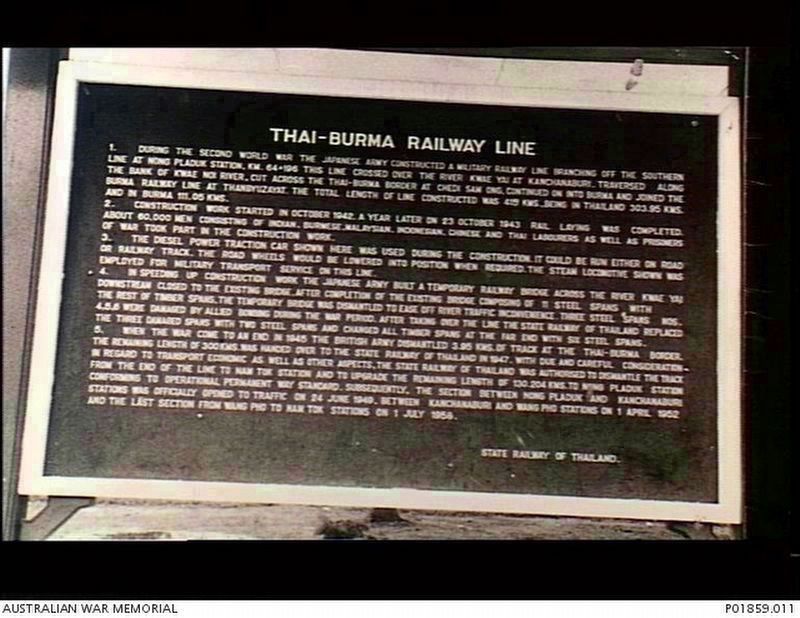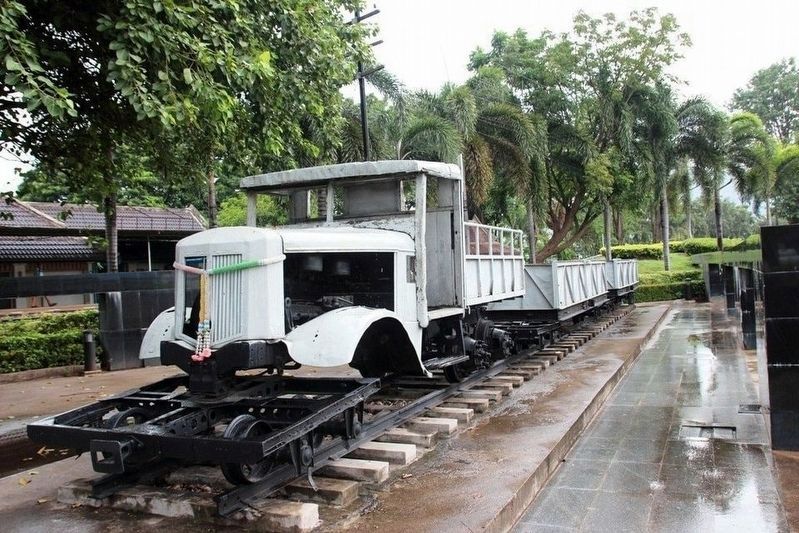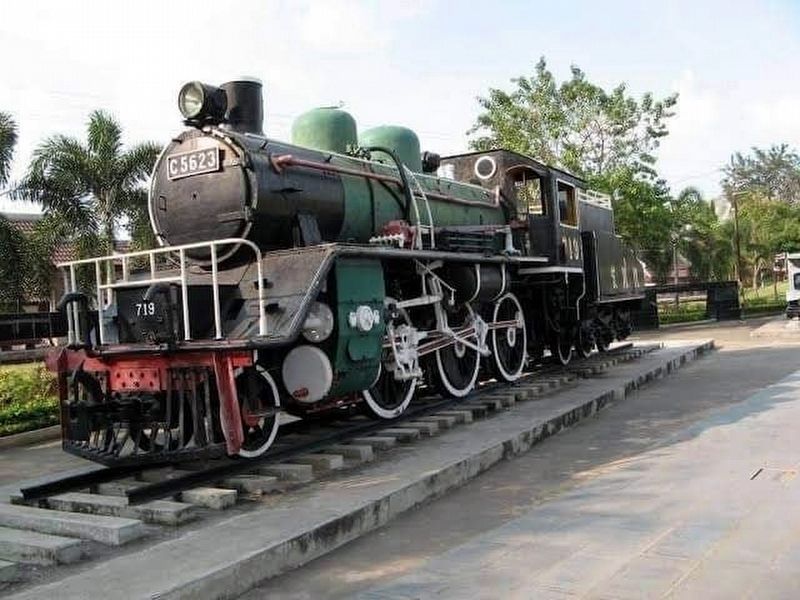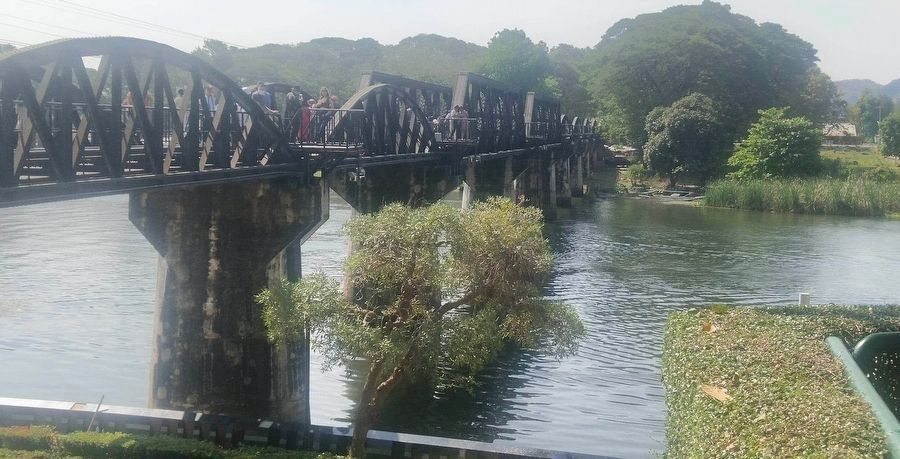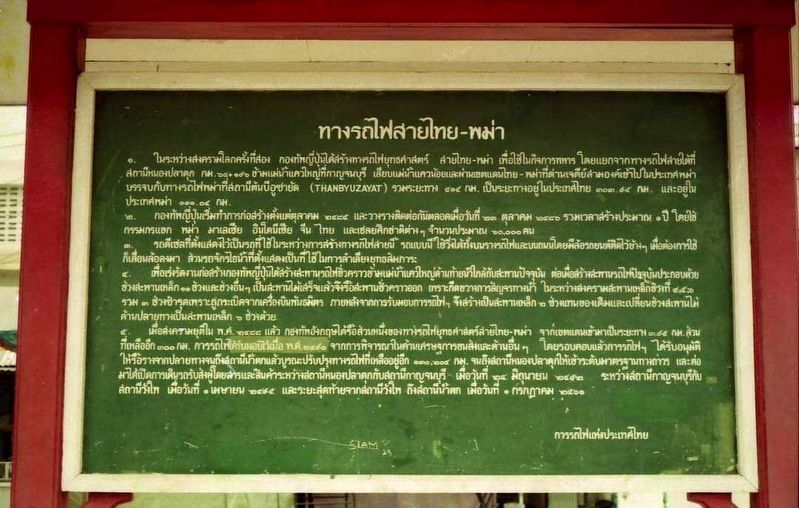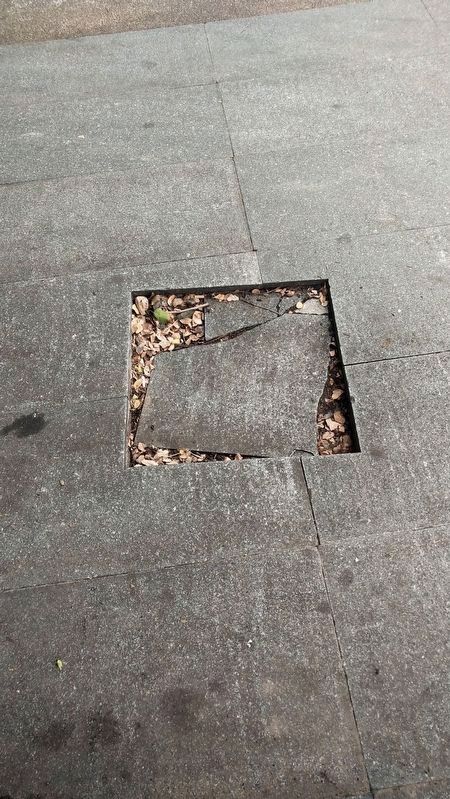Tha Ma Kham in Amphoe Mueang Kanchanaburi, Kanchanaburi, Thailand — ประเทศไทย (Southeast Asia, Indochinese Peninsula)
Thai-Burma Railway Line
1. During the Second World War the Japanese Army constructed a military railway line branching off the southern line at Nong Pladuk station, km 64-196. This line crossed over the River Kwai at Kanchanaburi, traversed along the bank of Khwae Noi River, cut across the Thai-Burma border at Chedi Sam Ong, continued on into Burma and joined the Burma Railway line at Thanbyuzayat. The total length of line constructed was 415 kms long; in Thailand 303.95 kms, and in Burma 111.05 kms.
2. Construction work started in October 1942. A year later on 23 October 1943 rail laying was completed. About 60.000 men consisting of Indian, Burmese, Malayans, Indonesian, Chinese and Thai labourers as well as Prisoners of War took part in the construction work.
3. The diesel power traction car shown here was used during the construction. It could be run either on road or railway track. The road wheels would be lowered into position when required. The steam locomotive shown was employed for military transport service on this line.
4. In speeding up construction work the Japanese Army built a temporary railway bridge across the river Khwae Yai downstream, close to the existing bridge. After completion of the existing bridge composed of steel spans, with the rest of timber spans. The temporary bridge was dismantled to ease off river traffic inconvenience. Three steel spans Nos. 4, 5, 6 were damaged by Allied bombing during the war period. After taking over the line the State Railway of Thailand replaced the three damaged spans with two steel spans and changed all timber spans at the far end with six steel spans.
5. When the war came to an end in 1945 the British Army dismantled 3.95 kms of track at the Thai-Burma border. The remaining length of 300 kms. was handed over to the State Railway of Thailand in 1947. With due and careful consideration in regard to transport economic as well as other aspects, the State railway of Thailand was authorized to dismantle the track from the end of the line to Nam Tok station and to upgrade the remaining length of 130.204 kms. to Nong Pladuk station, conforming to Operational Permanent Way standard. Subsequently, the section between Nong Pladuk and Kanchanaburi stations was officially opened to traffic on 24 June 1948 between Kanchanaburi and Wang Pho stations on 1 April 1952, and the last section from Wang Pho to Nam Tok stations on 1 July 1954.
Erected by State Railway of Thailand.
Topics and series. This historical marker is listed in these topic lists: Railroads & Streetcars • War, World II. In addition, it is included in the The Thailand-Burma Railway series list. A significant historical date for this entry is October 23, 1943.
Location. Marker is missing. It
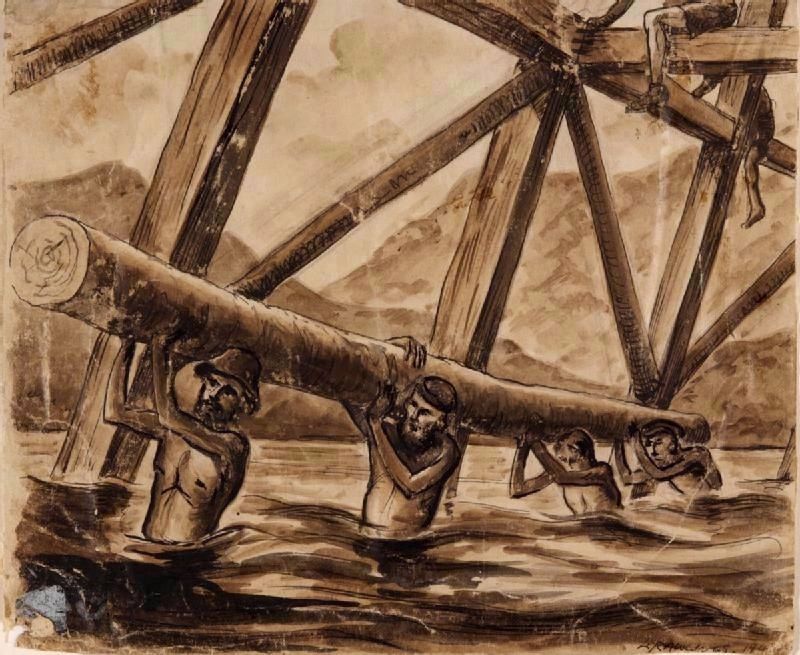
Sketch by Leo Rawlings (Public Domain) in the collection of the Imperial War Museum, London, 1943
2. “Bridge Over the River Kwai”
Leo Rawlings, a POW who was involved in the line's construction, made this sketch in 1943. It depicts four POWs, waist-deep in the water, carrying a large log during the first bridge’s construction.
Other nearby markers. At least 8 other markers are within 3 kilometers of this location, measured as the crow flies. The Bridge Over the River Kwae (within shouting distance of this marker); Burma-Thai Railway (about 210 meters away, measured in a direct line); VFW POW Kanchanaburi Memorial (about 210 meters away); Thai-Anusorn (about 210 meters away); The Kanchanaburi Memorial (approx. 2.6 kilometers away); Kanchanaburi War Cemetery (approx. 2.6 kilometers away); That Valiant Company Who Perished While Building the Railway (approx. 2.6 kilometers away); Tribute to Royal Dutch East Indies Army and the Royal Netherlands Navy Personnel Who Perished (approx. 2.6 kilometers away). Touch for a list and map of all markers in Tha Ma Kham.
Also see . . . Burma Railway Wikipedia entry. Excerpt:
One of the most notable portions of the entire railway line is Bridge 277, the so-called “Bridge on the River Kwai,” which was built over a stretch of the river that was then known as part(Submitted on June 29, 2023.)of the Mae Klong River. The greater part of the Thai section of the river’s route followed the valley of the Khwae Noi River (khwae, ‘stream, river or tributary’; noi, ‘small.’ Khwae was frequently mispronounced by non-Thai speakers as kwai, or ‘buffalo’ in Thai). This gave rise to the name of “River Kwai” in English. In 1960, because of discrepancies between facts and fiction, the portion of the Mae Klong which passes under the bridge was renamed the Khwae Yai (แควใหญ่ in the Thai language; in English, ‘big tributary’).
On 26 October 1942, British prisoners of war arrived at Tamarkan to construct the bridge. Initially, 1,000 prisoners worked on the bridge and were commanded by Colonel Philip Toosey. In February 1943, 1,000 Dutch prisoners of war were added to Tamarkan. An unknown number of Malayan workers were housed in a nearby camp.
he bridge was made famous by Pierre Boulle's novel The Bridge over the River Kwai and its film adaptation, The Bridge on the River Kwai.
Credits. This page was last revised on December 9, 2023. It was originally submitted on June 29, 2023, by Jj Karwacki of Tha Maka, Kanchanaburi. This page has been viewed 155 times since then and 18 times this year. Photos: 1. submitted on June 29, 2023, by Jj Karwacki of Tha Maka, Kanchanaburi. 2. submitted on June 29, 2023, by J. J. Prats of Powell, Ohio. 3, 4, 5. submitted on June 29, 2023, by Jj Karwacki of Tha Maka, Kanchanaburi. 6. submitted on December 8, 2023, by Jj Karwacki of Tha Maka, Kanchanaburi. 7. submitted on July 10, 2023, by Jj Karwacki of Tha Maka, Kanchanaburi. • J. J. Prats was the editor who published this page.
Editor’s want-list for this marker. a better photograph of this marker • a wide photograph showing the marker in its surrounding • Can you help?
